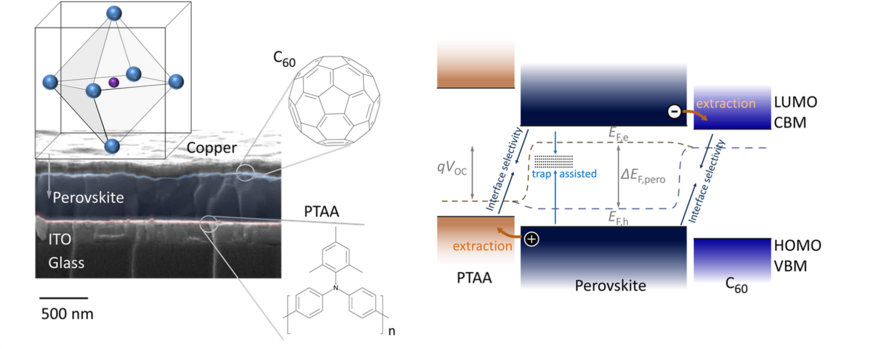Development of pin-type perovskite cells
The Perovskite group has long experience in the fabrication of perovskite solar cells in the so-called pin-configuration at a world-record level. With 2 thin charge transport layers (e.g. 10 nm PTAA and 30 nm C60), these cells are rather simple and require generally no high-temperature treatments during fabrication (100 °C), despite delivering up to 21.5% PCE and long-time stabilities have been reported in recent publications. Our group has experience in the fabrication of various different perovskites, from MAPI to low-gap (FA-rich) to wide-gap (Br-rich) double and triple cation perovskites, tin-based perovskite and two-dimensional perovskites.
A key aspect of this research topic is the search for optimal charge transport layers that induce little interfacial recombination losses in order to maintain the high efficiency potential of the perovskite absorber layer and to maximize the stability of the cell. Moreover, we aim to apply interfacial layers to suppress across-interface recombination by slowing the transfer of the minority carrier and to passivate defects at the perovskite surface. Find out more in this recent publications!
References:
- Wolff, C. M. et al. Perfluorinated Self-Assembled Monolayers Enhance the Stability and Efficiency of Inverted Perovskite Solar Cells. ACS Nano 14, 1445–1456 (2020).
- Stolterfoht, M. et al. Visualization and suppression of interfacial recombination for high-efficiency large-area pin perovskite solar cells. Nat. Energy 3, 847–854 (2018).
- Stolterfoht, M. et al. The impact of energy alignment and interfacial recombination on the internal and external open-circuit voltage of perovskite solar cells. Energy Environ. Sci. 12, 2778–2788 (2019).
- Caprioglio, P. et al. High open circuit voltages in pin-type perovskite solar cells through strontium addition. Sustain. Energy Fuels 3, 550–563 (2019).
- Saliba, M. et al. How to Make over 20% Efficient Perovskite Solar Cells in Regular ( n–i–p ) and Inverted ( p–i–n ) Architectures. Chem. Mater. 30, 4193–4201 (2018).
- Stolterfoht, M. et al. Approaching the fill factor Shockley–Queisser limit in stable, dopant-free triple cation perovskite solar cells. Energy Environ. Sci. 10, 1530–1539 (2017).
- Zhang, S. et al. The Role of Bulk and Interface Recombination in High‐Efficiency Low‐Dimensional Perovskite Solar Cells. Adv. Mater. 1901090 (2019). doi:10.1002/adma.201901090
- Wolff, C. M. et al. Reduced Interface-Mediated Recombination for High Open-Circuit Voltages in CH3NH3PbI3 Solar Cells. Adv. Mater. 29, 1700159 (2017).

